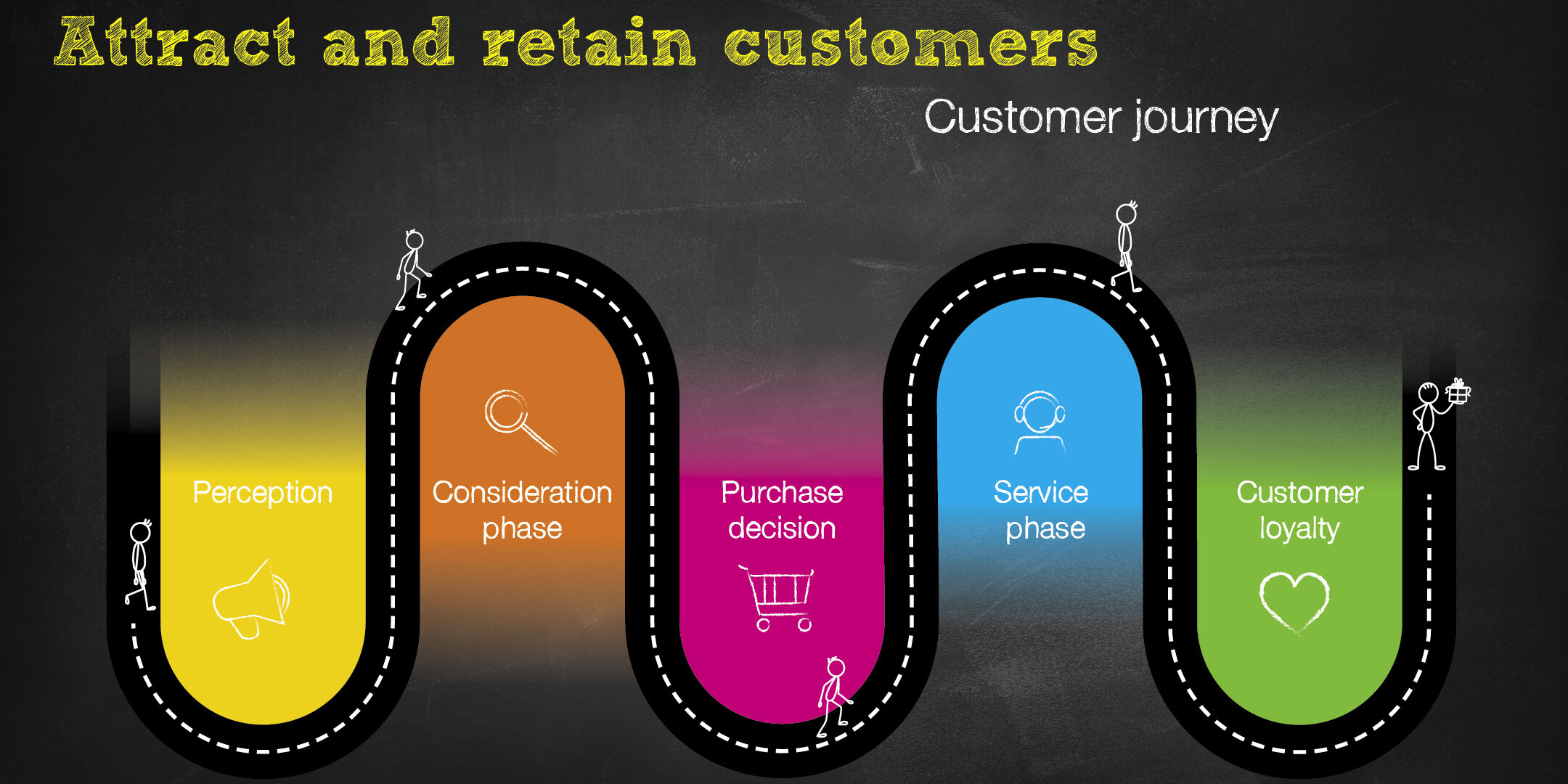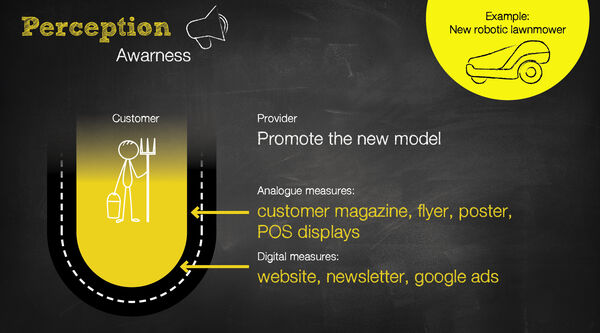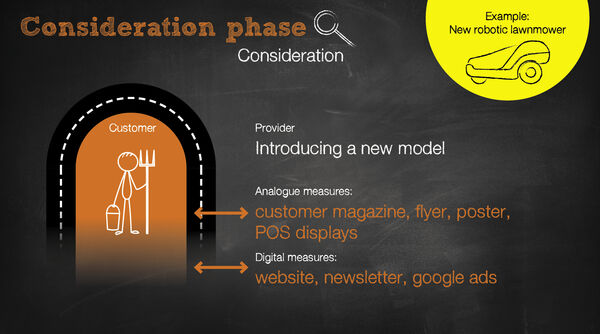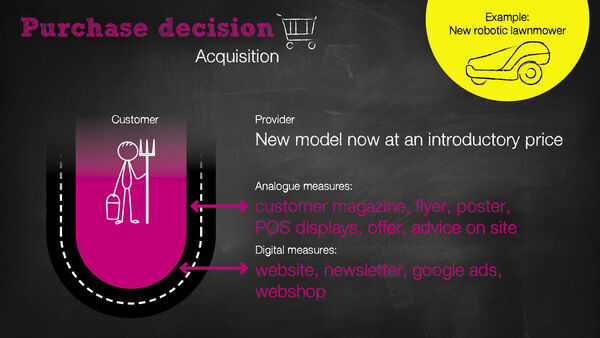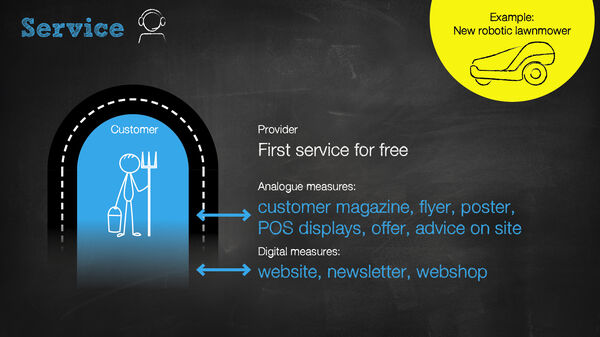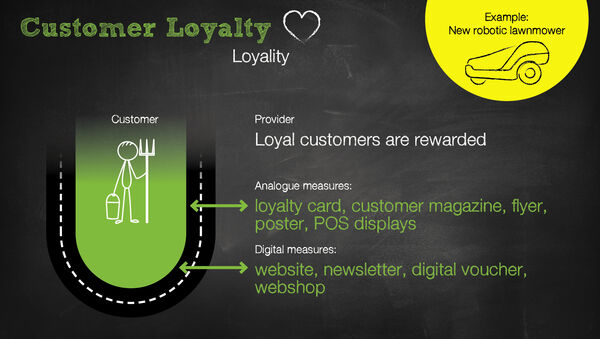The customer journey models how and where customers find out about a product and what points of contact they may have with a company. The difficulty is that not all customers have the same needs or are looking for the same solutions to problems. This makes successful marketing challenging, especially as advertising opportunities have multiplied due to digitalization but the budgets for this tend to be smaller. Nevertheless, the model is very helpful, especially for annual marketing planning.
Basically, the higher the value of the product or service, the longer the customer journey. This is because before a customer spends a lot of money, they usually obtain comprehensive information about their investment.
Landscaper Markus* consistently asks his customers how they came to him and why they placed the order with him. He has noticed that most of his customers have spent a long time, sometimes over a year, gathering information. They examined and compared various offers and weighed up the pros and cons. Many of his customers have positively emphasised that he has a very informative website with good references, where they were able to get a good picture of the range of services.
For retail gardener Martina*, it is a little more difficult to get specific feedback from her customers as to why they buy from her: Many have known her for a long time; it's simply the nursery in their neighbourhood where they shop. And yet the frequency is constantly decreasing.
Most of the marketing measures planned by SMEs start with the purchase decision. In other words, you plan a marketing campaign and expect a direct, measurable benefit from it. It's like sowing a seed and reaping the harvest a few days later. This may work for certain products/services, but as with gardening, patience and continuous care bring a diverse yield.
It is often underestimated that the needs and knowledge of a society are constantly changing. The coronavirus pandemic has made this clear. People suddenly spent more time at home, which in some cases created completely new needs. Customers often don't know how to satisfy these new needs.
Perception
This phase is about making customers aware of a product or service. It is particularly important to publicise new or less well-known products or services. This phase is all about emotion and information. One industry that masters this very well is the automotive industry. There, new cars are presented with very elaborate campaigns.
One of the biggest misconceptions of SMEs is the view that the customer knows the company and already knows everything once something has been communicated a few times. This is definitely not the case. On the contrary, due to the enormous flood of information, every single piece of information loses value. That's why it's crucial to communicate the most important points again and again, ideally via different channels.
During the coronavirus pandemic, for example, the need for houseplants increased dramatically as people spent a lot of time at home or working from home and realized that something was missing. The need for houseplants grew. However, if customers in this situation don't know that Martina has a wide range of houseplants, they will buy them elsewhere.
Those who engage in intensive dialogue with their customers are often surprised to discover that most customers don't even know what you offer.
Consideration phase
Once the need is there, it naturally wants to be satisfied. In the consideration phase, the customer compares various offers and thinks about what suits them best. He collects information and compares the options. Special offers are also included in the considerations. To score points in this phase, it is worth asking the customer about their most important decision criteria. As mentioned in the first article, it's not always just the price. You may be able to score points with completely different criteria.
The following also applies in this phase: the higher the planned expenditure, the longer and more intensive the consideration phase.
Purchase decision
Ultimately, the decisive factor for any business is that the customer decides to make a purchase or place an order. The most popular method of triggering a purchase is through discounts and other benefits. However, these usually have a short-term effect and are relatively easy to measure.
Martina has realised that regular discounts have made her customers price-sensitive and discussions about discounts have increased significantly. - A vicious circle that is difficult to break.
Yet it is precisely in this phase that a specialist shop can score points. This is because customers often have a clear idea of what they want, but may forget important items that are also needed. For example, an irrigation computer usually requires a battery, often a square one, which is not exactly common in households. It must therefore be a matter of course to ask the customer about this. With a little practice and good employee training, this is relatively easy and brings great added value for the customer and ultimately also for the company.
Many salespeople are reluctant to suggest additional sales. Most of them are a service for the customer, as many don't inform themselves properly when buying and don't even know what they need. And using the example of the battery, it can be very annoying for the customer if they want to put the irrigation system into operation and then realise that they need a battery that they don't have and that they first have to organise.
The purchasing phase is of course very important for Markus, as this phase determines whether his offer is successful or not. This phase can therefore take a little longer and involve a lot of questions and adjustments.
Service phase
The service phase is often underestimated, especially in the case of larger investments. Customers want to know, for example, how to maintain the garden, where they can get spare parts for the robotic lawnmower or who can give them information if the plants are not growing properly.
Many of these questions are already included in the consideration phase. It is therefore important for potential customers to see what services you offer and how you will support your customers after the purchase. This gives them a good feeling and can have a significant influence on their purchasing decision.
Loyalty
This phase has great potential from the company's point of view and yet is underutilised, especially by SMEs and in the green sector. It is much cheaper to maintain existing customers than to constantly acquire new ones. A good and up-to-date address database is a valuable asset for any company. Today there are numerous simple systems for customer cards, address management, newsletters etc. that are also manageable for small companies.
Utilise this potential and get in regular contact with your customers and inform them about news, tried and tested products, events and trends. This information is always a good reason to reward existing customers.
When it comes to rewards, people often think far too generously and believe that they have to give large discounts on the entire product range. However, small gifts often have a much more lasting effect and are much cheaper for the company. Surprise your customers with small gifts.
A journey with many interruptions
Corporate communication often lacks a common thread. The advertising style, the message or even the appearance is changed too often. Recognition value is an important factor for a successful customer journey. The more often the customer comes into contact with the logo and the company's most important recognisable features, the more likely it is to be remembered. It also helps to win back former customers if the company is remembered positively.
Another challenge lies in the combination of digital and analogue marketing, including in the customer journey. There are no clear trends as to which means should be used to advertise in which phase and how the customer can best be picked up in each phase. What is important here, however, is the common thread that runs through both worlds and ideally complements each other.
However, numerous studies clearly show that there are hardly any purely analogue or digital customer journeys today.
In this context, it is important for Martina* to know that, contrary to popular belief, over 85% of retail sales are still made in bricks-and-mortar stores, even though a large proportion of these customers have researched online before making a purchase.
Best practice
Not every phase of a customer journey needs to be covered equally well. Depending on the product and investment costs, different phases are decisive for the purchase decision. The promotion of the different phases can be well distributed over the different seasons. For example, service offers should be advertised primarily in the low season, while the purchase decision should be promoted primarily in the high season.
Customer feedback is particularly helpful in creating the most successful customer journey possible. Ask your customers how they came to you, what they liked, what could be better, why they decided in favour of your offer, etc. Personal customer contact and the opportunity to interact with the customer and derive a benefit from this are major advantages of the retail grower over the wholesale trade.
The customer journey is not a rigid approach, but should be constantly adapted to new needs and market conditions and, among other things, answer the question of why the customer should buy from you. Especially in today's world, where a huge range of products can be called up and compared in a short space of time, it is important to work out the differences. Why should the customer buy the geraniums from Martina or have the garden maintenance done by Markus?
In the next part, we look at the various analogue marketing options.
*Markus has a thriving landscaping business with 20 employees. He is mainly active in the private sector, mainly doing high-quality remodelling and maintenance work. The order books are usually full months in advance. So Markus asks himself why he should spend money on marketing when things are going well anyway.
*Martina runs a small garden retail business in a good location with her own plant production, mainly seasonal flowers, herbs and vegetables. She has been able to count on a loyal clientele for a long time, but is slowly realising that her customers are getting older and older and tending to decline. Martina wonders how she can attract more customers with her small marketing budget.


